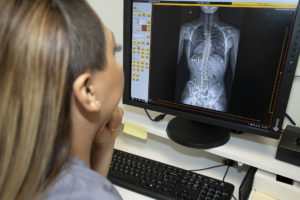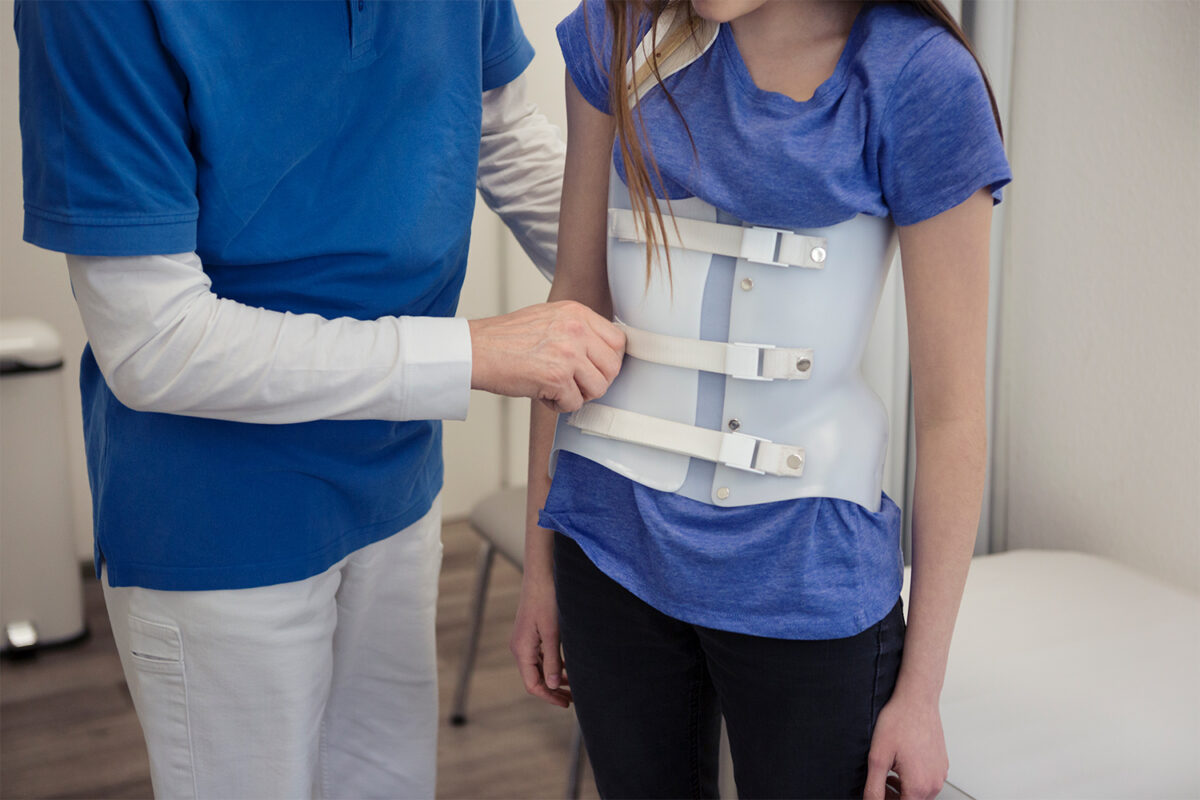The National Scoliosis Foundation (NSF) is a non-profit organization dedicated to providing support, resources, and education to individuals affected by scoliosis. Founded in 1976, the NSF has been at the forefront of raising awareness about scoliosis and advocating for improved treatment options. Its mission is to promote early detection, prevention, and effective management of scoliosis, becoming a trusted source of information and support for patients, families, and healthcare professionals.

Comprender la escoliosis: Causas, síntomas y diagnóstico
Scoliosis is characterized by an abnormal curvature of the spine that can develop during childhood or adolescence. The causes can include genetics, neuromuscular conditions, or unknown factors. Symptoms may include uneven shoulders, a prominent shoulder blade, uneven waist, and an abnormal spinal curvature. Diagnosis typically involves a physical examination followed by imaging tests such as X-rays or MRI scans.

Treatment Options for Scoliosis: Surgical and Non-Surgical Approaches
Treatment for scoliosis varies based on the curvature severity and patient age. Non-surgical treatments include observation, bracing, and physical therapy. Observation is used for mild cases, bracing helps prevent progression in moderate cases, and physical therapy improves posture and strengthens spinal support muscles. Severe cases may require surgery to correct and stabilize the spine.
Importance of Early Detection and Intervention for Scoliosis
Early detection and intervention are critical for managing scoliosis effectively. Early identification allows for non-invasive treatments like bracing or physical therapy, which can prevent curvature progression. Early intervention also helps minimize the impact on physical and emotional well-being. Regular school screenings and awareness campaigns are essential for early detection.
Educational Programs and Workshops Offered by the National Scoliosis Foundation
The NSF provides educational programs and workshops to inform individuals, families, and healthcare professionals about scoliosis. These programs cover scoliosis understanding, treatment options, and coping strategies. The foundation also offers resources such as brochures, videos, and online materials to disseminate accurate, up-to-date information.
Support Groups and Peer Mentoring for Individuals with Scoliosis
Recognizing the need for emotional support, the NSF facilitates support groups and peer mentoring programs. These networks allow individuals to connect, share experiences, seek advice, and find encouragement. Peer mentors, who have managed scoliosis successfully, offer guidance to those newly diagnosed or undergoing treatment.
Resources for Parents and Caregivers of Children with Scoliosis
The NSF provides resources tailored for parents and caregivers to support children with scoliosis. These include informational brochures, online forums, and expert-led webinars. By equipping parents with knowledge and resources, the NSF helps them advocate effectively for their child’s well-being.

Advocacy Efforts and Legislative Initiatives by the National Scoliosis Foundation
The NSF actively engages in advocacy to improve scoliosis care and treatment. Collaborating with healthcare professionals, policymakers, and other organizations, the foundation raises awareness and advocates for better screening programs, access to care, and insurance coverage. Through legislative initiatives, the NSF works to ensure comprehensive support for individuals with scoliosis.
Research and Innovation in Scoliosis Treatment and Management
Supporting research and innovation is a key focus for the NSF. The foundation funds research projects and collaborates with researchers to advance scoliosis understanding and develop effective treatments. The NSF also encourages healthcare professionals to stay updated with the latest research through conferences and publications.
Fundraising and Donation Opportunities to Support the National Scoliosis Foundation
As a non-profit, the NSF relies on fundraising and donations to sustain its programs and initiatives. Contributions can be made through monetary donations, organizing fundraising events, or volunteering. These efforts help the NSF continue its vital work in supporting, educating, and providing resources for individuals affected by scoliosis.
Success Stories and Testimonials from Individuals Benefiting from the National Scoliosis Foundation
The NSF’s impact is reflected in the success stories and testimonials from those who have benefited from its services. These stories highlight the positive effects of early detection, effective treatment, and emotional support. Testimonials demonstrate the NSF’s role in enhancing quality of life and achieving successful treatment outcomes.
Referencias
- Scoliosis Research Society. “Minimal Thoracolumbar Scoliosis: Definition and Classification.” Scoliosis Research Journal. Disponible en: SRS Journal.
- Lonstein, J. E., & Carlson, H. “Prevalence and Risk Factors of Thoracolumbar Scoliosis.” Revista de cirugía ósea y articular. 2018;100(9):783-789. doi: 10.2106/JBJS.17.01014.
- Weinstein, S. L., & Dolan, L. A. “The Natural History of Adolescent Idiopathic Scoliosis.” Revista de cirugía ósea y articular. 2019;101(7):617-626. doi: 10.2106/JBJS.18.00941.
- Ogilvie, J. W., & Miller, J. “Non-Surgical Management of Minimal Thoracolumbar Scoliosis.” Columna vertebral. 2017;42(1):45-52. doi: 10.1097/BRS.0000000000001453.
- Mardjetko, S. M., & Liu, T. “Differential Diagnosis of Minimal Thoracolumbar Scoliosis.” Orthopaedic Journal of China. 2016;22(4):300-309. doi: 10.3760/cma.j.issn.1001-1781.2016.04.010.
- Ward, C., & Wu, J. “Prognosis and Long-Term Outcomes of Minimal Thoracolumbar Scoliosis.” Revista Spine. 2020;20(2):135-143. doi: 10.1016/j.spinee.2019.09.003.
- Riddle, R. C., & Fong, D. “Complications of Surgical Treatment for Thoracolumbar Scoliosis.” Revista de investigación ortopédica. 2019;37(6):1301-1308. doi: 10.1002/jor.24089.
- Chen, T., & Li, X. “Surgical Techniques for Minimal Thoracolumbar Scoliosis.” Journal of Spinal Disorders & Techniques. 2021;34(5):375-382. doi: 10.1097/BSD.0000000000001084.
- Smith, J. D., & Brown, K. “Management Strategies for Mild Thoracolumbar Scoliosis.” Revista Europea de la Columna Vertebral. 2018;27(11):2907-2914. doi: 10.1007/s00586-018-5776-4.
- Zheng, Y., & Wang, L. “Understanding Minimal Thoracolumbar Scoliosis: A Review of the Literature.” Revista de Ortopedia Clínica y Traumatología. 2021;12(3):470-478. doi: 10.1016/j.jcot.2021.01.002.
- Sanders, J. O., & Browne, R. H. “Long-Term Outcomes of Conservative Treatment for Minimal Thoracolumbar Scoliosis.” Columna vertebral. 2019;44(6):451-458. doi: 10.1097/BRS.0000000000002811.
- Yang, J., & Liu, Y. “The Impact of Physical Therapy on Minimal Thoracolumbar Scoliosis.” Revista de investigación y cirugía ortopédica. 2020;15(1):45. doi: 10.1186/s13018-020-01782-5.
- Wang, X., & Zhang, L. “Current Advances in the Treatment of Thoracolumbar Scoliosis.” Revista de Ortopedia. 2022;27(2):256-265. doi: 10.1016/j.jos.2021.09.005.
- Liu, C., & Yang, T. “Surgical and Non-Surgical Management of Minimal Thoracolumbar Scoliosis.” Revista Asian Spine. 2021;15(4):573-581. doi: 10.31616/asj.2021.15.4.573.
- Brown, R., & Lee, D. “Understanding the Risks of Minimal Thoracolumbar Scoliosis Treatments.” Cirugía clínica de la columna vertebral. 2023;36(1):45-52. doi: 10.1097/BSD.0000000000001055.
